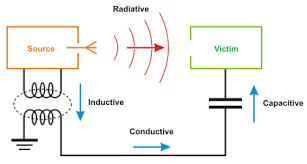Practical PCB Design Rules
Because many things can affect transmission lines, EMI problems can occur. In order to reduce these problems, good PCB design is important and with some simple design rules, the PCB designer can minimize these problems. It is important to make prudent decisions during new circuit design, like the minimum number of layers. The easiest way to get a good, new design is to copy the recommended design from the TI evaluation modules (EVM).
A good PCB layout starts with the circuit design. Do not postpone considerations about the layout. One of the most important aspects affecting the layout is the location of each functional block. Keep their devices and their traces together.
PCB Considerations During the Circuit Design
· What is the highest frequency and fastest rise time in the system?
· What are the electrical specifications at the inputs and outputs of the sinks and sources?
· Are there sensitive signals to route – for example, think about controlled impedance, termination,propagation delay on a trace (clock distribution, buses, etc.)
· Is a microstrip adequate for the sensitive signals, or is it essential to use stripline technique?
· How many different supply voltages exist? Does each supply voltage need its own power plane, or is it possible to split them?
· Create a diagram with the functional groups of the system – e.g., transmitter path, receiver path,analog signals, digital signals, etc.
· Are there any interconnections between at least two independent functional groups? Take special care of them. Think about the return current and crosstalk to other traces.
· Clarify the minimum width, separation and height of a trace with the PCB manufacturer. What's the minimum distance between two layers? What about the minimum drill and the requirements of vias? Is it possible to use blind vias and buried vias?
Equipped with this information, a designer can do a lot of basic design.
A good PCB layout starts with the circuit design. Do not postpone considerations about the layout. One of the most important aspects affecting the layout is the location of each functional block. Keep their devices and their traces together.
PCB Considerations During the Circuit Design
· What is the highest frequency and fastest rise time in the system?
· What are the electrical specifications at the inputs and outputs of the sinks and sources?
· Are there sensitive signals to route – for example, think about controlled impedance, termination,propagation delay on a trace (clock distribution, buses, etc.)
· Is a microstrip adequate for the sensitive signals, or is it essential to use stripline technique?
· How many different supply voltages exist? Does each supply voltage need its own power plane, or is it possible to split them?
· Create a diagram with the functional groups of the system – e.g., transmitter path, receiver path,analog signals, digital signals, etc.
· Are there any interconnections between at least two independent functional groups? Take special care of them. Think about the return current and crosstalk to other traces.
· Clarify the minimum width, separation and height of a trace with the PCB manufacturer. What's the minimum distance between two layers? What about the minimum drill and the requirements of vias? Is it possible to use blind vias and buried vias?
Equipped with this information, a designer can do a lot of basic design.


Comments
Post a Comment